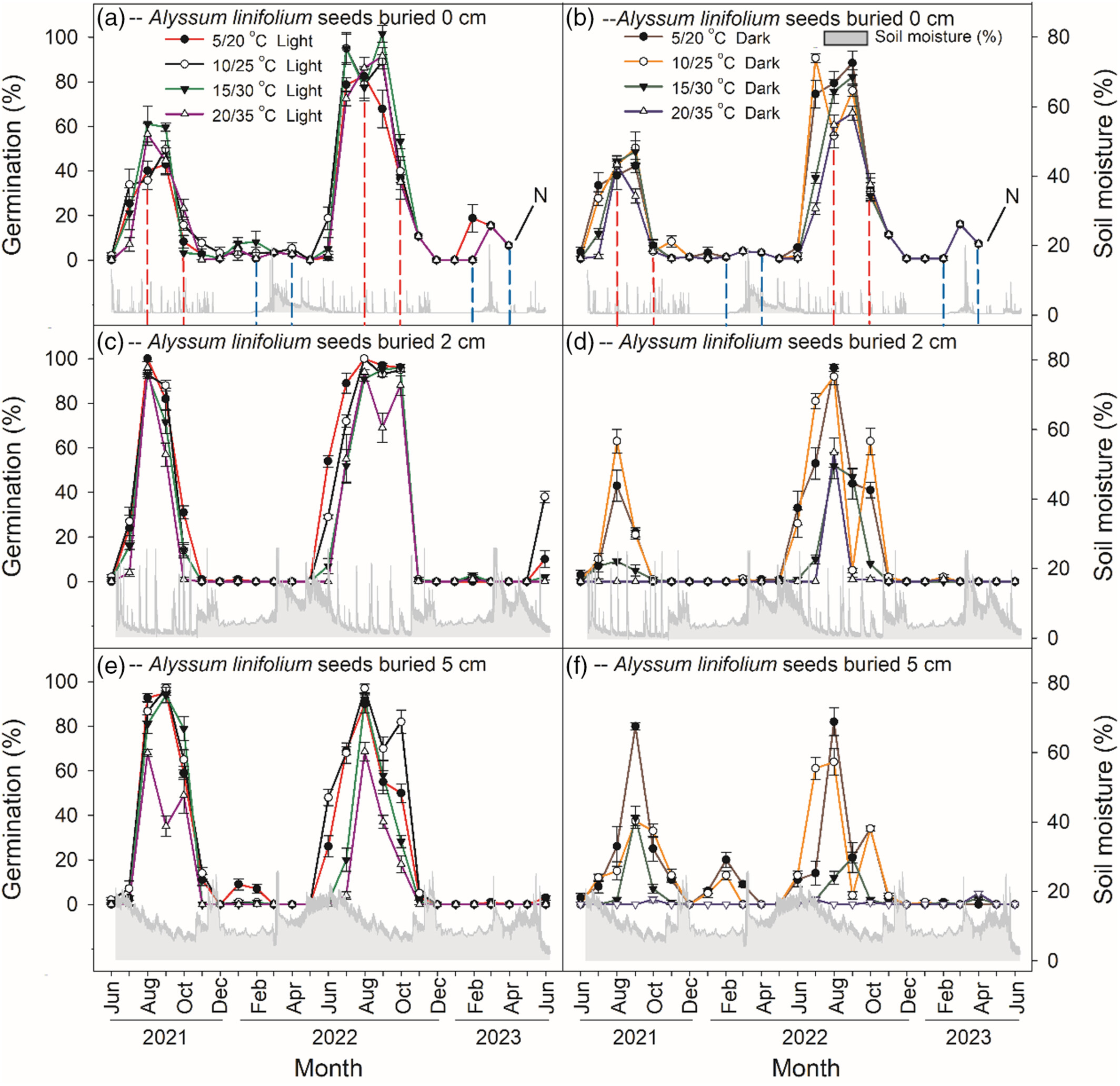A Research team led by Prof. HUANG Zhenying from the Institute of Botany of the Chinese Academy of Sciences has discovered a fascinating survival strategy-a unique seed dormancy cycling mechanism in two desert ephemeral plants, Alyssum linifolium and Tetracme quadricornis. This research reveals how these plants adapt to the extreme conditions of the Gurbantunggut Desert in Central Asia by going through two dormancy cycles each year. This allows them to produce two different groups of seedlings annually.
The findings, published in the Journal of Ecology, offer new insights into how desert plants manage to survive in such unpredictable environments.
Desert ephemeral plants are special because they complete their entire life cycle quickly during short periods of favorable conditions, like after rainfall or snowmelt. They rely heavily on their seeds to survive the long, harsh dry seasons. The timing of seed dormancy and germination is critical for their survival, as it must align perfectly with environmental cues to ensure the seedling can grow successfully. However, the exact mechanisms behind how these seeds manage their dormancy cycling have been unclear until now.
The study focused on understanding the life-history strategies of A. linifolium and T. quadricornis. Over two years of field and laboratory experiments, the researchers found that the seeds of both plants go through a unique twice-a-year dormancy cycle. When the seeds first mature, they are dormant and cannot germinate. However, during the hot summer, this dormancy is gradually broken through a process called dry after-ripening. This allows the seeds to germinate in autumn if there is enough moisture in the soil moisture. But if the seeds fail to germinate in autumn, they go back into dormancy during the winter. Then, in early spring, some of these dormant seeds can break their dormancy again through a brief period of cold stratification, allowing them to germinate once more.
This means that each year, there are two groups of seedlings: one that germinates in autumn and another in spring. A. linifolium mostly produces autumn-germinated (AG) seedlings, while T. quadricornis mostly produces spring-germinated (SG) seedlings. The AG plants have a longer growth period but less likely to survive, whereas the SG plants grow quickly and have a higher chance of survival. This strategy of having two germination periods acts like a bet-hedging strategy, helping the plants cope with the unpredictable rainfall and temperature changes in the desert.
This research not only deepens our knowledge of how plants manage dormancy and germination but also highlights the resilience of desert plants in adapting to their challenging environments. It sheds light on the ecological adaptations of desert plants, offering valuable insights into their survival mechanisms in extreme environments.
The study was a collaborative effort with researchers from the Xinjiang Institute of Ecology and Geography, the University of Kentucky, and the Ben-Gurion University of the Negev.

Dormancy cycle of soil seeds of two ephemeral plants (Image by GUO Ruru et al.)
A Research team led by Prof. HUANG Zhenying from the Institute of Botany of the Chinese Academy of Sciences has discovered a fascinating survival strategy-a unique seed dormancy cycling mechanism in two desert ephemeral plants, Alyssum linifolium and Tetracme quadricornis. This research reveals how these plants adapt to the extreme conditions of the Gurbantunggut Desert in Central Asia by going through two dormancy cycles each year. This allows them to produce two different groups of seedlings annually.
The findings, published in the Journal of Ecology, offer new insights into how desert plants manage to survive in such unpredictable environments.
Desert ephemeral plants are special because they complete their entire life cycle quickly during short periods of favorable conditions, like after rainfall or snowmelt. They rely heavily on their seeds to survive the long, harsh dry seasons. The timing of seed dormancy and germination is critical for their survival, as it must align perfectly with environmental cues to ensure the seedling can grow successfully. However, the exact mechanisms behind how these seeds manage their dormancy cycling have been unclear until now.
The study focused on understanding the life-history strategies of A. linifolium and T. quadricornis. Over two years of field and laboratory experiments, the researchers found that the seeds of both plants go through a unique twice-a-year dormancy cycle. When the seeds first mature, they are dormant and cannot germinate. However, during the hot summer, this dormancy is gradually broken through a process called dry after-ripening. This allows the seeds to germinate in autumn if there is enough moisture in the soil moisture. But if the seeds fail to germinate in autumn, they go back into dormancy during the winter. Then, in early spring, some of these dormant seeds can break their dormancy again through a brief period of cold stratification, allowing them to germinate once more.
This means that each year, there are two groups of seedlings: one that germinates in autumn and another in spring. A. linifolium mostly produces autumn-germinated (AG) seedlings, while T. quadricornis mostly produces spring-germinated (SG) seedlings. The AG plants have a longer growth period but less likely to survive, whereas the SG plants grow quickly and have a higher chance of survival. This strategy of having two germination periods acts like a bet-hedging strategy, helping the plants cope with the unpredictable rainfall and temperature changes in the desert.
This research not only deepens our knowledge of how plants manage dormancy and germination but also highlights the resilience of desert plants in adapting to their challenging environments. It sheds light on the ecological adaptations of desert plants, offering valuable insights into their survival mechanisms in extreme environments.
The study was a collaborative effort with researchers from the Xinjiang Institute of Ecology and Geography, the University of Kentucky, and the Ben-Gurion University of the Negev.

Dormancy cycle of soil seeds of two ephemeral plants (Image by GUO Ruru et al.)
